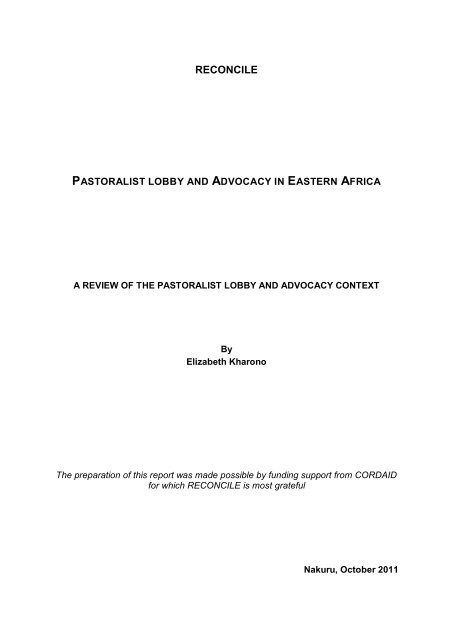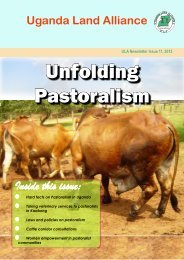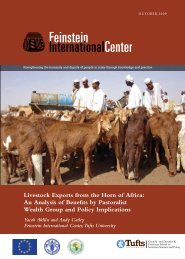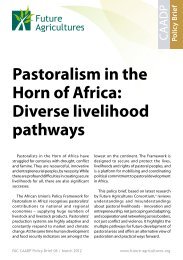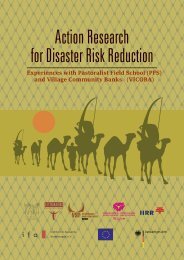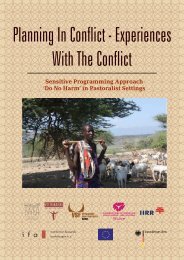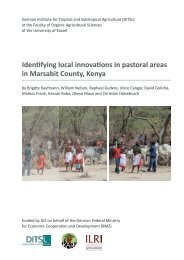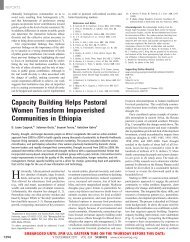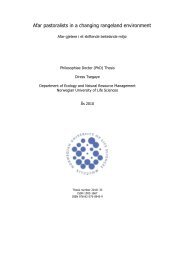Pastoralist lobby and advocacy in Eastern Africa - celep
Pastoralist lobby and advocacy in Eastern Africa - celep
Pastoralist lobby and advocacy in Eastern Africa - celep
Create successful ePaper yourself
Turn your PDF publications into a flip-book with our unique Google optimized e-Paper software.
RECONCILEPASTORALIST LOBBY AND ADVOCACY IN EASTERN AFRICAA REVIEW OF THE PASTORALIST LOBBY AND ADVOCACY CONTEXTByElizabeth KharonoThe preparation of this report was made possible by fund<strong>in</strong>g support from CORDAIDfor which RECONCILE is most gratefulNakuru, October 2011
Table of ContentsAcronyms .......................................................................................................................................... 21. Introduction ........................................................................................................................... 31.1. Terms of reference <strong>and</strong> approach to work ....................................................................... 31.2. Limitations of this review ............................................................................................... 42. Pastoral development <strong>in</strong> <strong>Eastern</strong> <strong>Africa</strong> – policy context ........................................................ 42.1. Pastoral development <strong>in</strong> the context of national development policy frameworks ............ 52.2. L<strong>and</strong> Policies <strong>and</strong> Laws – challenges <strong>and</strong> opportunities for pastoral development ......... 102.3. Regional policy frameworks <strong>and</strong> pastoral development ................................................. 143. Civil society <strong>in</strong>itiatives <strong>in</strong> <strong>Eastern</strong> <strong>Africa</strong>– an overview .................................................... 173.1 <strong>Pastoralist</strong> <strong>lobby</strong> <strong>and</strong> <strong>advocacy</strong> – an emerg<strong>in</strong>g movement ................................................... 183.2. Key challenges ............................................................................................................. 224. <strong>Pastoralist</strong> Lobby <strong>and</strong> Advocacy Facility .............................................................................. 234.1. Justification for the <strong>lobby</strong> <strong>and</strong> <strong>advocacy</strong> facility ........................................................... 244.2. Views on Need for a <strong>Pastoralist</strong> Lobby <strong>and</strong> Advocacy Facility...................................... 255. Conclusion ........................................................................................................................... 27References ................................................................................................................................... 291 | P a g e
AcronymsAUCAADPCOMESACOPACSOCORDSEACGTPHoAPNIGADKLAMDGsNEPADNSGRPPASDEPPDNKPEAPPFEPFFSPAPINGOsPRSPsRECONCILEREGLAPTALAUCRTULA<strong>Africa</strong>n UnionComprehensive <strong>Africa</strong>n Agriculture Development ProgrammeCommon Market for <strong>Eastern</strong> <strong>and</strong> Southern <strong>Africa</strong>Coalition of Pastoral Civil Society OrganizationsCommunity Research <strong>and</strong> Development ServicesEast <strong>Africa</strong>n CommunityGrowth <strong>and</strong> Transformation PlanHorn of <strong>Africa</strong> <strong>Pastoralist</strong>s NetworkIntergovernmental Authority on DevelopmentKenya L<strong>and</strong> AllianceMillennium Development GoalsNew Partnership for <strong>Africa</strong>’s DevelopmentNational Strategy for Growth <strong>and</strong> Reduction of PovertyPlan for Accelerated Development to End Poverty<strong>Pastoralist</strong> Development Network of KenyaPoverty Eradication Action Plan<strong>Pastoralist</strong>s Forum EthiopiaPolicy Framework for Food Security <strong>in</strong> <strong>Pastoralist</strong> Areas<strong>Pastoralist</strong>s Indigenous Non-Governmental OrganizationsPoverty Reduction Strategy PapersResource Conflict InstituteRegional Learn<strong>in</strong>g <strong>and</strong> Advocacy Programme for VulnerableDryl<strong>and</strong> CommunitiesTanzania L<strong>and</strong> AllianceUjamaa Community Resources TrustUg<strong>and</strong>a L<strong>and</strong> Alliance2 | P a g e
1. IntroductionThis report presents the outcome of a review of the pastoralist <strong>lobby</strong> <strong>and</strong> <strong>advocacy</strong> context <strong>in</strong><strong>Eastern</strong> <strong>Africa</strong> which was undertaken on behalf of RECONCILE to <strong>in</strong>form the consultativeprocess it is facilitat<strong>in</strong>g on how to further improve the organisation <strong>and</strong> capacity ofpastoralists <strong>and</strong> civil society to <strong>in</strong>fluence policy processes at local, national, regional <strong>and</strong>global levels on an on-go<strong>in</strong>g basis. The outcome of this review highlights the need tostrengthen on-go<strong>in</strong>g pastoralist <strong>lobby</strong> <strong>and</strong> <strong>advocacy</strong> efforts due to the fast-chang<strong>in</strong>g policycontext <strong>and</strong> <strong>in</strong>creased pressure on pastoralist l<strong>and</strong> <strong>and</strong> resources <strong>in</strong> the region. This needprovides a justification for sett<strong>in</strong>g up a <strong>lobby</strong> <strong>and</strong> <strong>advocacy</strong> facility the nature <strong>and</strong> make-up ofwhich civil society organisations <strong>and</strong> other stakeholders <strong>in</strong>volved <strong>in</strong> pastoral developmentwill need to determ<strong>in</strong>e.This report is divided <strong>in</strong>to four parts. Follow<strong>in</strong>g this <strong>in</strong>troduction, the second section of thereport discusses selected national <strong>and</strong> regional policy <strong>and</strong> legal frameworks <strong>and</strong> theopportunities <strong>and</strong> challenges they present for the development of pastoralist communities <strong>and</strong>pastoralism as a production system. The third section presents an overview of civil society<strong>lobby</strong> <strong>and</strong> <strong>advocacy</strong> <strong>in</strong>itiatives, the strategies use highlight<strong>in</strong>g some of the challenges theyface. This next part of the report presents feedback on the proposal to set up a <strong>Pastoralist</strong>Lobby <strong>and</strong> Advocacy Facility for <strong>Eastern</strong> <strong>Africa</strong> start<strong>in</strong>g with the justification by itsproponents. The report ends with a conclusions section.1.1. Terms of reference <strong>and</strong> approach to workThe review was done to achieve the follow<strong>in</strong>g specific objectives:1. Identify <strong>and</strong> analyse policies <strong>and</strong> laws which have a bear<strong>in</strong>g on pastoralist development <strong>in</strong>terms of the opportunities <strong>and</strong> challenges they offer for pastoralist <strong>lobby</strong> <strong>and</strong> <strong>advocacy</strong> toprovide a rationale <strong>and</strong> justification for sett<strong>in</strong>g up a <strong>Pastoralist</strong> Lobby <strong>and</strong> AdvocacyFacility <strong>in</strong> <strong>Eastern</strong> <strong>Africa</strong>2. Identify <strong>and</strong> analyse on-go<strong>in</strong>g pastoralist <strong>lobby</strong> <strong>and</strong> <strong>advocacy</strong> <strong>in</strong>itiatives <strong>in</strong> Kenya,Ug<strong>and</strong>a, Tanzania <strong>and</strong> Ethiopia, highlight<strong>in</strong>g who the key actors are, their level ofeffectiveness <strong>and</strong> impact <strong>and</strong> how they <strong>in</strong>teract,3. Determ<strong>in</strong>e whether there is a shared need, justification <strong>and</strong> rationale for sett<strong>in</strong>g up apastoralist <strong>lobby</strong> <strong>and</strong> <strong>advocacy</strong> framework, <strong>and</strong> what form such a facility should take.3 | P a g e
The review was undertaken over a period of 20 days <strong>and</strong> it <strong>in</strong>volved assessment of national<strong>and</strong> regional legal <strong>and</strong> policy frameworks, identify<strong>in</strong>g <strong>and</strong> exam<strong>in</strong><strong>in</strong>g on-go<strong>in</strong>g pastoralistcivil society <strong>lobby</strong> <strong>and</strong> <strong>advocacy</strong> <strong>in</strong>itiatives which also <strong>in</strong>cluded a review of a wide range ofmaterials generated by these organisations. Field visits were undertaken to Ug<strong>and</strong>a,Tanzania, Ethiopia <strong>and</strong> Kenya dur<strong>in</strong>g which discussions were held with key stakeholders <strong>in</strong>each of the countries <strong>and</strong> <strong>in</strong>sights about the specific national context <strong>and</strong> the opportunities<strong>and</strong> challenges for <strong>advocacy</strong> efforts to support pastoralism were gleaned.1.2. Limitations of this reviewThe terms of reference for this review were far more ambitious than what could be realisticallycovered <strong>in</strong> the time available. Inevitably, therefore, a number of trade-offs had to be made. Eventhough efforts were made to document the many useful <strong>in</strong>itiatives which exemplify good practice <strong>and</strong>lessons learned, this proved impractical <strong>and</strong> unrealistic given the time available. The review ofpolicies <strong>and</strong> legal frameworks which have a bear<strong>in</strong>g on pastoralist development, also had to be toneddown to few national <strong>and</strong> regional policies <strong>and</strong> legal frameworks given the wide range of suchframeworks at the respective national level <strong>and</strong> also regional <strong>and</strong> even global level. In this regard,only a few national <strong>and</strong> regional policy frameworks which have recently come <strong>in</strong>to effect <strong>and</strong> whichshould be currently guid<strong>in</strong>g policy action have been reviewed.2. Pastoral development <strong>in</strong> <strong>Eastern</strong> <strong>Africa</strong> – policy contextThe national policy context <strong>in</strong> <strong>Eastern</strong> <strong>Africa</strong> is constantly chang<strong>in</strong>g <strong>in</strong> response to global,regional <strong>and</strong> national realities <strong>and</strong> imperatives. These various changes present bothopportunities <strong>and</strong> challenges for pastoralist development, generally, <strong>and</strong> pastoralist <strong>lobby</strong> <strong>and</strong><strong>advocacy</strong> efforts, specifically. Ethiopia, Tanzania <strong>and</strong> Ug<strong>and</strong>a concluded one 5-year cycle oftheir poverty reduction strategy papers 1 <strong>and</strong> started another 5-year cycle for the period2010/11 – 2014/15. Kenya, on the other h<strong>and</strong>, is implement<strong>in</strong>g the first 5-year medium-termroll<strong>in</strong>g plan under its Vision 2030 which covers the period 2008-2012. These new overarch<strong>in</strong>gpolicy frameworks 2 provide the strategic direction for each country to achieve itsmedium term development objectives.The policy frameworks give a good <strong>in</strong>dication of the extent to which policy makers <strong>in</strong><strong>Eastern</strong> <strong>Africa</strong> have come to appreciate pastoralism, the unique development challenges1 Ethiopia: Plan for Accelerated <strong>and</strong> Susta<strong>in</strong>ed Development to end Poverty (2005/6 – 2009/10), Tanzania:MKUKUTA I (2005/6 – 2009/10), <strong>and</strong> Ug<strong>and</strong>a: Poverty Eradication Action Plan (2004/5 – 2007/8)2 Ethiopia: the Growth <strong>and</strong> Transformation Plan, Tanzania: MKUKUTA II, <strong>and</strong> Ug<strong>and</strong>a: the NationalDevelopment Plan;4 | P a g e
which pastoralist communities face, <strong>and</strong> the priority it is accorded <strong>in</strong> the overall policyframework. Recent developments <strong>in</strong> Kenya have had a significant impact on that country’slegal <strong>and</strong> policy context. More than any other country <strong>in</strong> the region, Kenya’s new legal <strong>and</strong>policy frameworks 3 provide the most positive considerations for pastoralist development <strong>and</strong>a good example of how countries <strong>in</strong> <strong>Eastern</strong> <strong>Africa</strong> can overcome change the currentperception of provid<strong>in</strong>g the least supportive policy environment for pastoralist developmentcompared to other regions <strong>in</strong> <strong>Africa</strong>.Previous reviews of policy <strong>and</strong> legal trends <strong>and</strong> the support they provide for the developmentof pastoralism <strong>and</strong> pastoralist communities <strong>in</strong> the countries of <strong>Eastern</strong> <strong>Africa</strong> 4 have <strong>in</strong>dicatedthat, even though governments <strong>in</strong> the region are beg<strong>in</strong>n<strong>in</strong>g to accord recognition topastoralism, translat<strong>in</strong>g policy commitments <strong>in</strong>to practical <strong>in</strong>terventions to support <strong>and</strong>promote pastoralism <strong>and</strong> pastoralist livelihoods has proved elusive. This review has foundthat, while these observations rema<strong>in</strong> largely true for some countries – <strong>in</strong> particular Tanzania<strong>and</strong> Ug<strong>and</strong>a – the policy situation for Kenya has dramatically changed <strong>and</strong> that of Ethiopiahas also shown marked improvements <strong>in</strong> recognis<strong>in</strong>g <strong>and</strong> seek<strong>in</strong>g to address pastoralistdevelopment as an <strong>in</strong>tegral dimension of overall national development.This review assesses the various national policy legal frameworks mentioned above todeterm<strong>in</strong>e the extent to which these challenges persist. Given the fact that the overarch<strong>in</strong>gpolicy frameworks will be guid<strong>in</strong>g policy action for the next couple of years, this reviewexam<strong>in</strong>es what opportunities exist with<strong>in</strong> them for <strong>in</strong>creased <strong>lobby</strong> <strong>and</strong> <strong>advocacy</strong> <strong>in</strong> supportof pastoralist development.2.1. Pastoral development <strong>in</strong> the context of national development policyframeworksPoverty Reduction Strategy Papers (PRSPs) have been over-arch<strong>in</strong>g policy frameworks forcountries <strong>in</strong> <strong>Eastern</strong> <strong>Africa</strong> s<strong>in</strong>ce the eve of the 21 st century. They evolved out of the globalconsensus build<strong>in</strong>g processes which resolved to address global poverty <strong>and</strong> hunger, <strong>and</strong> have,s<strong>in</strong>ce 2000, been the ma<strong>in</strong> national level policy frameworks for achiev<strong>in</strong>g the MillenniumDevelopment Goals (MDGs). As such, therefore, national policy frameworks aimed at3 <strong>Pastoralist</strong> development is well articulated <strong>in</strong>, for <strong>in</strong>stance, Kenya’s Vision 2030, its Vision 2030 DevelopmentStrategy for Northern Kenya <strong>and</strong> other Arid L<strong>and</strong>s, its new Constitution, its National Policy for development ofNorthern Kenya <strong>and</strong> other Arid L<strong>and</strong>s <strong>and</strong> its National L<strong>and</strong> Policy4 See for <strong>in</strong>stance: Omondi & Odhiambo: Pastoralism, policies <strong>and</strong> practice <strong>in</strong> the Horn <strong>and</strong> East <strong>Africa</strong>,REGLAP, (2009); Marilse Turnbull: REGLAP Policy Basel<strong>in</strong>e, REGLAP, (2010)5 | P a g e
Alv<strong>in</strong> MilesLake Charles, LouisianaExecutive Master of Bus<strong>in</strong>ess Adm<strong>in</strong>istrationKennesaw State UniversityDoctor of Bus<strong>in</strong>ess Adm<strong>in</strong>istrationKennesaw State University, Fall 2013Dissertation Proposal Title:“An Exam<strong>in</strong>ation of the Effects of Leadership on Team Performance:When Does Leadership Style Make a Difference?”Dissertation Committee:Steve Werner, PhD, University of HoustonJoseph Astrachan, PhD, Kennesaw State UniversityVijay Patel, DBAForsyth, GeorgiaMaster of Bus<strong>in</strong>ess Adm<strong>in</strong>istrationUniversity of Western OntarioDoctor of Bus<strong>in</strong>ess Adm<strong>in</strong>istrationKennesaw State UniversityDissertation Title:“Extended Stakeholder Orientation: Influence on InnovationOrientation <strong>and</strong> Firm Performance”Dissertation Committee:Joseph F. Hair, Jr., PhD, Kennesaw State UniversityTorsten Pieper, PhD, Kennesaw State University
(PASDEP) 7 prior to its current Growth <strong>and</strong> Transformation Plan (GTP). It also reportshav<strong>in</strong>g registered above-average performance <strong>in</strong> the economic <strong>and</strong> social sectors. For<strong>in</strong>stance it achieved 63% <strong>in</strong> provision of veter<strong>in</strong>ary cl<strong>in</strong>ics <strong>and</strong> animal health services (2,275)aga<strong>in</strong>st a set target of 3,600 <strong>and</strong> surpassed its set target of 3,000 of tra<strong>in</strong>ees <strong>in</strong> delivery ofbasic veter<strong>in</strong>ary services achiev<strong>in</strong>g 4,144 (138%) 8 .The above positive aspects of the national development policy frameworks <strong>and</strong> theopportunities they provide can, <strong>and</strong> need to be exploited to realise concrete ga<strong>in</strong>s forpastoralist communities <strong>in</strong> the respective countries. In cases where governments admithav<strong>in</strong>g registered success <strong>in</strong> implement<strong>in</strong>g their strategies, they need to be directly engaged toscale up the successes for more wide-spread <strong>and</strong> susta<strong>in</strong>ed impacts especially amongstpastoralist communities. Prioritisation of agriculture <strong>and</strong> rural development, <strong>and</strong> thecont<strong>in</strong>ued focus on poverty <strong>and</strong> hunger reduction can be utilised to focus attention onpastoralist regions which tend to be <strong>in</strong> remote areas, <strong>and</strong> on livestock based ruraldevelopment given the fact that for pastoral communities, livestock are the key assets forboth livelihoods security <strong>and</strong> development.2.1.2. Challenges <strong>in</strong> the over-arch<strong>in</strong>g policy frameworksThe above opportunities notwithst<strong>and</strong><strong>in</strong>g, many challenges will have to be addressed if therespective national policy frameworks are to work for pastoralist communities <strong>in</strong> concreteways.a) Lack of specific mention of pastoralist development needsSome policy frameworks do not pay specific attention to pastoralism, choos<strong>in</strong>g <strong>in</strong>stead toaddress what might be concerns for pastoralist livelihoods <strong>in</strong>directly <strong>and</strong> with<strong>in</strong> other policycategories such as water development <strong>and</strong> construction of water dams, irrigation <strong>and</strong> foodsecurity, or livestock management <strong>and</strong> market<strong>in</strong>g of animal products. This implicit ratherthan explicit reference to pastoralism via the products it generates <strong>and</strong> the services required tomake it work is most evident <strong>in</strong> Ug<strong>and</strong>a’s National Development Plan <strong>and</strong> Tanzania’sNSGRP II. Indeed, the two countries depict the least appreciation <strong>and</strong> even hostility topastoralism as a production system. Their approaches seem to be based on the assumptionthat strategies <strong>in</strong>tended for non-pastoralist communities will apply <strong>in</strong> pastoralist areas.7 Plan for Accelerated <strong>and</strong> Susta<strong>in</strong>ed Development to end Poverty (PASDEP)8 Federal Democratic Republic of Ethiopia, GTP, 9.8 | P a g e
This “<strong>in</strong>visibility” of pastoralism means that its benefits to the economies of the respectivecountries can cont<strong>in</strong>ue to be exploited without the obligation to <strong>in</strong>vest <strong>in</strong>to it to address theconstra<strong>in</strong>ts faced by pastoralist producers. The challenge which pastoralist <strong>lobby</strong> <strong>and</strong><strong>advocacy</strong> must, therefore, face is to ensure that pastoralists’ contribution to the achievementof the objectives of the respective development plans is quantified <strong>and</strong> made visible <strong>and</strong> thatthe specific constra<strong>in</strong>ts to pastoralism as a production <strong>and</strong> livelihood system are addressed.b) <strong>Pastoralist</strong> mobility as a challengeWith the exception of Kenya, <strong>and</strong> to a limited extent Ethiopia, there is a persistent perceptionof pastoral mobility as a challenge which must be conta<strong>in</strong>ed. Implicit <strong>in</strong> the priorities whichare likely to benefit pastoralists is the desire to regulate pastoralist mobility <strong>in</strong> order to permitother l<strong>and</strong> use purposes <strong>in</strong> regions where pastoralism is practiced. It is evident that the policythrusts <strong>in</strong> each case is not to design enabl<strong>in</strong>g policy responses to allow mobility, which is socentral to the practice of pastoralism, but rather to limit it so that other l<strong>and</strong> users can haveaccess to l<strong>and</strong>.This presents several challenges to development <strong>in</strong> pastoral areas. First, it is evident from thedesire to restrict pastoralist mobility that the policies have not fully grasped the logic beh<strong>in</strong>dmobility which is an essential part of pastoralist production, <strong>and</strong> understood that it is an<strong>in</strong>tegral cop<strong>in</strong>g strategy for the dry-l<strong>and</strong> regions <strong>in</strong>habited by pastoralists. The secondchallenge is the cont<strong>in</strong>ued disregard of the communal l<strong>and</strong> rights of pastoralist communities<strong>and</strong> the right for them not to be dispossessed of their l<strong>and</strong> without consultation or adequatecompensation.Some governments <strong>in</strong> the region cont<strong>in</strong>ue to view pastoralists’ l<strong>and</strong> as unutilized orunderutilized <strong>and</strong> to target them for alienation to support other l<strong>and</strong> uses <strong>in</strong>clud<strong>in</strong>g cropfarm<strong>in</strong>g for small holder farmers, as is evident <strong>in</strong> Tanzania <strong>and</strong> Ug<strong>and</strong>a, or large-scalecommercial agriculture, as is proposed by Ethiopia <strong>and</strong> Tanzania <strong>in</strong> their Growth <strong>and</strong>Transformation Plan <strong>and</strong> NSGRP II, respectively.c) The pastoralist reality <strong>in</strong> agriculture <strong>and</strong> rural developmentEven though prioritisation of agriculture <strong>and</strong> rural development has been noted above aspresent<strong>in</strong>g an opportunity for enhanc<strong>in</strong>g pastoralist development, the challenge which has tobe addressed is the policy bias towards settled agriculture implicit <strong>in</strong> the policy frameworks.This bias is evident <strong>in</strong> the areas which countries <strong>in</strong>dicate will be highlighted for public9 | P a g e
<strong>in</strong>vestment <strong>in</strong> order to <strong>in</strong>crease agricultural productivity. Both Tanzania <strong>and</strong> Ethiopia<strong>in</strong>dicate their desire to promote large scale agriculture, which, <strong>in</strong> the case of Ethiopia, will<strong>in</strong>clude establish<strong>in</strong>g large scale farms to grow crops for bio-fuels. Ethiopia’s GTP also<strong>in</strong>dicates that, <strong>in</strong> a bid to <strong>in</strong>crease agricultural productivity <strong>and</strong> food security, emphasis willbe placed on production of “high value crops” <strong>and</strong> br<strong>in</strong>g<strong>in</strong>g most farmers to the highperformance levels of “model farmer”.Tanzania’s Kilimo Kwanza 9 strategy, launched <strong>in</strong> 2009 as a private-sector driven publicprivatepartnership for achiev<strong>in</strong>g <strong>in</strong>creased agricultural productivity, focuses on crop farm<strong>in</strong>g.Preference for large-scale farm<strong>in</strong>g for export <strong>and</strong> the high appetite exhibited by governmentsto encourage foreign <strong>in</strong>vestment <strong>and</strong> the penetration of external markets <strong>in</strong>to rural areas, eventhough it might present opportunities for <strong>in</strong>creased <strong>in</strong>vestments which benefit pastoralistdevelopment, also present threats as they might, <strong>in</strong> fact, witness more aggressiveappropriation of l<strong>and</strong> <strong>in</strong> rural areas, particularly of l<strong>and</strong> for pastoralist communities.2.2. L<strong>and</strong> Policies <strong>and</strong> Laws – challenges <strong>and</strong> opportunities for pastoraldevelopmentNone of the countries covered <strong>in</strong> this review have specific laws <strong>and</strong> policies which addresspastoralist tenure security. <strong>Pastoralist</strong> l<strong>and</strong> rights issues, if at all addressed are covered underbroad legal <strong>and</strong> policy frameworks. Ug<strong>and</strong>a, Ethiopia <strong>and</strong> now Kenya, either recognisecommunal l<strong>and</strong> rights or explicitly recognise the l<strong>and</strong> rights of pastoral communities <strong>in</strong> theirconstitutions. L<strong>and</strong> Acts <strong>and</strong> L<strong>and</strong> Policies have also <strong>in</strong> some cases made specific mention ofpastoralists <strong>and</strong> their l<strong>and</strong> rights. This section discusses some of the challenges whichpastoralists face <strong>in</strong> spite of acknowledgement of pastoralism <strong>and</strong> the rights of pastoralists <strong>in</strong>these legal <strong>and</strong> policy documents.a) Failure to address pastoralist tenure security <strong>and</strong> rightsLack of explicit protection <strong>and</strong> safeguards for the l<strong>and</strong> rights of pastoralist communitiespresents one of the greatest challenges to the practice of pastoralism. The communal l<strong>and</strong>rights on the basis of which pastoralists assert their claims on l<strong>and</strong> are <strong>in</strong>sufficientlydeveloped <strong>and</strong> are no match when pitted aga<strong>in</strong>st the more formal statutory claims over l<strong>and</strong>.The fact that communal law is not sufficiently developed has made it relatively easy forgovernments to alienate pastoral l<strong>and</strong>s for other l<strong>and</strong> use purposes, <strong>in</strong>clud<strong>in</strong>g activities whichare <strong>in</strong>compatible with the practice of pastoralism.9 Literally means “Agriculture First” <strong>and</strong> def<strong>in</strong>es agriculture <strong>in</strong> its broadest term to <strong>in</strong>clude animal husb<strong>and</strong>ry.10 | P a g e
In their bid to serve what they perceive to be national development <strong>in</strong>terests, governments areplay<strong>in</strong>g a central role <strong>in</strong> appropriat<strong>in</strong>g pastoralists’ l<strong>and</strong> ostensibly to encourage local <strong>and</strong>foreign <strong>in</strong>vestments. <strong>Pastoralist</strong> throughout <strong>Eastern</strong> <strong>Africa</strong> are experienc<strong>in</strong>g this ever<strong>in</strong>creas<strong>in</strong>gpressure as the areas they occupy are targeted because, compared to areasoccupied by farm<strong>in</strong>g communities, l<strong>and</strong> is seen as be<strong>in</strong>g available <strong>and</strong> under-utilised. Giventhis vested <strong>in</strong>terest <strong>in</strong> pastoral l<strong>and</strong>, it is no wonder that policy pronouncements on the l<strong>and</strong>rights of pastoralists tend to either be detrimental to the practice of pastoralism, or where theyare positive they rema<strong>in</strong> on paper <strong>and</strong> are not translated <strong>in</strong>to practice.Ug<strong>and</strong>a’s National L<strong>and</strong> Policy, which has been recently published, while recognis<strong>in</strong>g thel<strong>and</strong> rights of pastoralists <strong>and</strong> guarantee<strong>in</strong>g government protection for these rights, states thatsuch rights will only be guaranteed as long as they are not exercised at the expense of nonpastoralistcommunities 10 . Constitutional provisions for the l<strong>and</strong> rights of communities orpastoralists, such as are provided for <strong>in</strong> the Ug<strong>and</strong>an <strong>and</strong> Ethiopian constitutions, are notaccompanied by specific legislation to operationalize them. When conflicts betweenpastoralists <strong>and</strong> other l<strong>and</strong> users, occur, legislation tends to work <strong>in</strong> favour of those other l<strong>and</strong>uses (Fiona Fl<strong>in</strong>tan, et al, 2011).Lack of effective legal frameworks to protect the l<strong>and</strong> rights of pastoralist communitiespresents a major challenge to pastoralist development <strong>and</strong> survival. These challenges arealready becom<strong>in</strong>g evident <strong>in</strong> some of the countries <strong>in</strong> the region where pastoralist groups, <strong>and</strong>civil society organisations act<strong>in</strong>g on behalf of pastoralist communities, are struggl<strong>in</strong>g aga<strong>in</strong>stmany odds try<strong>in</strong>g to defend those rights. Countries which are promot<strong>in</strong>g large-scalecommercial farm<strong>in</strong>g, irrigation <strong>and</strong> dam projects, <strong>and</strong> which have openly declared the desireto facilitate the penetration of markets <strong>in</strong> rural areas, are likely to present the greatestchallenge because they target areas occupied by pastoralists where l<strong>and</strong> is not only seen to beavailable <strong>and</strong> abundant, but also under-utilised.b) Kenya – a ray of hope for pastoralism <strong>in</strong> <strong>Eastern</strong> <strong>Africa</strong>?Recent developments <strong>in</strong> Kenya confirm the fact that challenges fac<strong>in</strong>g pastoralism <strong>and</strong> thedevelopment of pastoralist communities will not simply fade away, <strong>and</strong> that countries <strong>in</strong><strong>Eastern</strong> <strong>Africa</strong> will, sooner or later, have to address them either <strong>in</strong> response to the deepen<strong>in</strong>gwelfare needs of pastoralists who become destitute because of “fall<strong>in</strong>g off the cliff” or hav<strong>in</strong>g10 Republic of Ug<strong>and</strong>a, M<strong>in</strong>istry of L<strong>and</strong>s, Hous<strong>in</strong>g <strong>and</strong> Urban Development: The Ug<strong>and</strong>a National L<strong>and</strong>Policy, p. 2611 | P a g e
to redress the imbalances created as a result of policy neglect <strong>and</strong> <strong>in</strong>sufficient <strong>in</strong>vestment <strong>in</strong>pastoral regions. Kenya’s new legal <strong>and</strong> policy framework depict a complete reversal of itsclose-to-fifty year development focus which was not only particularly hostile to thedevelopment of pastoralism but also resulted <strong>in</strong> policy neglect of arid <strong>and</strong> semi-arid regions<strong>in</strong> favour of better-endowed parts of the country 11 .Kenya’s Vision 2030 is the country’s long-term development bluepr<strong>in</strong>t aimed at creat<strong>in</strong>g acohesive, equitable <strong>and</strong> just society <strong>and</strong> at turn<strong>in</strong>g Kenya <strong>in</strong>to a “globally competitive <strong>and</strong>prosperous country with a high quality of life by 2030 12 .” Vision 2030 is anchored on threePillars – Economic, Social <strong>and</strong> Political. Under the Economic Pillar, the country seeks toachieve a 10% per annum growth rate, spurred by flagship projects <strong>in</strong> every sector over theperiod of the Vision. The growth realised as a result of this is expected to support theimplementation of MDGs on a susta<strong>in</strong>able basis. Under the Social Pillar Kenya seeks tocreate just, cohesive <strong>and</strong> equitable social development, while under the Political Pillar, itseeks to realise an issue-based, people-centred, results-oriented <strong>and</strong> accountable democraticsystem.A Vision 2030: Northern Kenya <strong>and</strong> other Arid L<strong>and</strong>s has been developed by the M<strong>in</strong>istry ofState for Development of Northern Kenya <strong>and</strong> other Arid L<strong>and</strong>s as frameworks foroperationaliz<strong>in</strong>g Vision 2030 with<strong>in</strong> the pastoralist areas of the country. The document alsoseeks to ensure that development projects undertaken <strong>in</strong> these areas facilitate rather thanunderm<strong>in</strong>e the practice of pastoralism.A National Policy for the Susta<strong>in</strong>able Development of Northern Kenya <strong>and</strong> other Arid L<strong>and</strong>shas been prepared by the M<strong>in</strong>istry <strong>and</strong> is presently before Cab<strong>in</strong>et await<strong>in</strong>g approval <strong>and</strong>release as a Sessional Paper. The National Policy addresses three dist<strong>in</strong>ct policy challengesparticular to Northern Kenya <strong>and</strong> other Arid L<strong>and</strong>s which have to be addressed <strong>in</strong> order torelease the potential of the region. These are: clos<strong>in</strong>g the development gap between NorthernKenya <strong>and</strong> other arid l<strong>and</strong>s <strong>and</strong> the rest of the country, protect<strong>in</strong>g <strong>and</strong> promot<strong>in</strong>g mobility <strong>and</strong><strong>in</strong>stitutional arrangements essential to productive pastoralism, <strong>and</strong> ensur<strong>in</strong>g food <strong>and</strong>nutrition security across Northern Kenya <strong>and</strong> other arid l<strong>and</strong>s.11 Republic of Kenya, 2011, Vision 2030 Development Strategy for Northern Kenya <strong>and</strong> other Arid L<strong>and</strong>s, p. 812 Republic of Kenya, 2007, Kenya Vision 203012 | P a g e
For its part, the Vision 2030: Northern Kenya <strong>and</strong> other Arid L<strong>and</strong>s document recognises thatdifferent parts of Kenya will move towards the country’s Vision 2030 from different start<strong>in</strong>gpo<strong>in</strong>ts <strong>and</strong> it highlights the fact that there will be need for accelerated <strong>in</strong>vestment <strong>in</strong>previously neglected regions of Kenya <strong>in</strong> order to give all parts of the country an equalchance of shar<strong>in</strong>g the promise <strong>and</strong> benefits <strong>in</strong> Vision 2030. It highlights the uniqueconditions to which policy <strong>and</strong> practice must adapt <strong>in</strong> order to ensure that the desiredaccelerated development is realised <strong>in</strong> Northern Kenya <strong>and</strong> other arid l<strong>and</strong>s. These <strong>in</strong>clude:aridity <strong>and</strong> the challenge this presents to efforts to ensure susta<strong>in</strong>able food <strong>and</strong> nutritionsecurity, diversity <strong>in</strong> economic activity requir<strong>in</strong>g disaggregated policy responses, <strong>and</strong>pastoralism as a dom<strong>in</strong>ant production system which requires appropriate policy responses toprotect <strong>and</strong> support mobility. It also draws attention to what it terms the “untapped potential”with<strong>in</strong> Northern Kenya <strong>and</strong> other Arid L<strong>and</strong>s which will be unlocked as a result of <strong>in</strong>creased<strong>and</strong> accelerated <strong>in</strong>vestment <strong>in</strong> the region. This potential is <strong>in</strong> the region’s strategic location,its domestic trade, livestock trade, tourism, natural wealth, urban development as well as theskills <strong>and</strong> knowledge it has on climate variability which can be drawn upon to avert thesevere impacts of climate change.Kenya’s L<strong>and</strong> Policy (2009) commits government to, among other th<strong>in</strong>gs, document <strong>and</strong> mapexist<strong>in</strong>g communal tenure <strong>in</strong> order to <strong>in</strong>corporate them <strong>in</strong>to broad pr<strong>in</strong>ciples to facilitateorderly evolution of community law. The Policy also places the responsibility on thegovernment to build the capacity of communal l<strong>and</strong> governance <strong>in</strong>stitutions <strong>and</strong> to facilitatetheir operations. Government is also given the responsibility to facilitate flexible <strong>and</strong>negotiated cross-boundary access amongst communities. This provision specifically benefits<strong>and</strong> supports cross-boundary mobility for pastoralists.It is, no doubt, too early to assess how well the above changes <strong>in</strong> Kenya will translate <strong>in</strong>toconcrete benefits which pastoralist communities recognise. However, Kenya has sufficientexperience from its previous policy stance to avoid a situation <strong>in</strong> which its policycommitments fail to be turned <strong>in</strong>to practice <strong>and</strong> mean<strong>in</strong>gful ga<strong>in</strong>s for communities liv<strong>in</strong>g <strong>in</strong>Northern <strong>and</strong> other Arid L<strong>and</strong>s, generally, <strong>and</strong> pastoralist communities, <strong>in</strong> particular. Thecurrent good will <strong>and</strong> momentum, however, puts the country <strong>in</strong> a good position to not onlymake good on its promises, but also be an example to other countries <strong>in</strong> the region on how toappreciate pastoralism as a production system <strong>and</strong> the policy responses which create therequired enabl<strong>in</strong>g environment for pastoralism <strong>in</strong> this region.13 | P a g e
2.3. Regional policy frameworks <strong>and</strong> pastoral developmentMany policy frameworks have been recently developed with<strong>in</strong> the m<strong>and</strong>ates of the differentregional <strong>in</strong>tergovernmental agencies <strong>in</strong>clud<strong>in</strong>g: the <strong>Africa</strong>n Union (AU), theIntergovernmental Authority on Development (IGAD), the East <strong>Africa</strong>n Community (EAC),the Common Market for <strong>Eastern</strong> <strong>and</strong> Southern <strong>Africa</strong> (COMESA) <strong>and</strong> the New Partnershipfor <strong>Africa</strong>’s Development (NEPAD). All these different policy <strong>in</strong>novations open up newopportunities but also challenges for pastoralist development <strong>in</strong> the region.In this section we consider two policy frameworks: the AU Policy Framework forPastoralism <strong>in</strong> <strong>Africa</strong> (October 2010) <strong>and</strong> the COMESA Policy Framework for Food Security<strong>in</strong> <strong>Pastoralist</strong> Areas (Draft: 2009) to illustrate this. The AU framework represents the firstsuch cont<strong>in</strong>ent-wide <strong>in</strong>itiative aimed at secur<strong>in</strong>g, protect<strong>in</strong>g <strong>and</strong> improv<strong>in</strong>g the lives,livelihoods <strong>and</strong> rights of <strong>Africa</strong>n pastoralists. The COMESA policy framework, on the otherh<strong>and</strong>, is very unique because of its conceptual framework which permits address<strong>in</strong>g overlapp<strong>in</strong>gissues critical to support<strong>in</strong>g pastoralist livelihoods – food security, pastoralism as aproduction system, <strong>and</strong> vulnerability.2.3.1. The AU Policy Framework for Pastoralism <strong>in</strong> <strong>Africa</strong>The underly<strong>in</strong>g objective of the AU Policy Framework is to provide the basis for pastoralpolicy development, implementation <strong>and</strong> monitor<strong>in</strong>g <strong>and</strong> evaluation. The key elements <strong>in</strong>apply<strong>in</strong>g the framework <strong>in</strong>clude <strong>in</strong>itiation of country level pastoral policy developmentprocesses which start with the establishment of a national steer<strong>in</strong>g committee <strong>and</strong> a national<strong>in</strong>ter-discipl<strong>in</strong>ary support team of experts. The policy development process is supposed to behighly participatory <strong>and</strong> <strong>in</strong>teractive <strong>and</strong> cover<strong>in</strong>g the follow<strong>in</strong>g elements, among others:clarify issues, def<strong>in</strong>e roles, <strong>in</strong>clud<strong>in</strong>g the role of <strong>in</strong>digenous <strong>in</strong>stitutions, consult withpastoralist communities, address legislative, <strong>in</strong>stitutional <strong>and</strong> operational issues, <strong>and</strong> ensureavailability of f<strong>in</strong>ancial resources.The objectives of the Policy Framework are shaped around two ma<strong>in</strong> areas: a) address<strong>in</strong>ggeneric policy constra<strong>in</strong>ts which arise from misconceptions <strong>and</strong> misunderst<strong>and</strong><strong>in</strong>gs ofpastoralism as a production system <strong>and</strong> way of life, <strong>and</strong> b) livestock production as a coreeconomic activity <strong>in</strong> pastoralist areas <strong>and</strong> approaches to protect <strong>and</strong> develop livestock assets.The first objective covers issues of pastoral representation, legitimacy of traditional pastoral<strong>in</strong>stitutions, commitment to pro-pastoral policies <strong>and</strong> <strong>in</strong>tegration of these policies <strong>in</strong> national<strong>and</strong> regional policy frameworks <strong>and</strong> the role of women. The second objective highlights the14 | P a g e
importance of mobility to make efficient use of rangel<strong>and</strong> resources, <strong>and</strong> the ecological <strong>and</strong>economic logic of enabl<strong>in</strong>g <strong>in</strong>-country <strong>and</strong> regional mobility. This objective also covers theneed for risk-based approaches to drought management <strong>in</strong> pastoral areas, <strong>and</strong> strategies forprotect<strong>in</strong>g core livestock assets dur<strong>in</strong>g drought as a means to encourage post-droughtrecovery.2.3.2. The COMESA Policy Framework for Food Security <strong>in</strong> <strong>Pastoralist</strong> Areas(PFFSPA)The COMESA Policy Framework was developed as a framework specific to the vulnerable<strong>and</strong> food <strong>in</strong>secure pastoralist populations <strong>in</strong> COMESA region to achieve Pillar III of theComprehensive <strong>Africa</strong>n Agriculture Development Programme (CAADP) of <strong>in</strong>creas<strong>in</strong>g foodsupply, reduc<strong>in</strong>g hunger <strong>and</strong> improv<strong>in</strong>g responses to food emergency crises. TheFramework exam<strong>in</strong>es the complex challenges fac<strong>in</strong>g pastoral communities with<strong>in</strong> the contextof its m<strong>and</strong>ate of promot<strong>in</strong>g free movement of goods, services <strong>and</strong> people. Accord<strong>in</strong>gly, theframework emphasises the need to view pastoralist areas <strong>in</strong> terms of cross-border economies<strong>and</strong> ecosystems <strong>and</strong> the necessity to put <strong>in</strong> place appropriate policies to support the practiceof pastoralism as a system of production <strong>in</strong> order to reduce food <strong>in</strong>security <strong>and</strong> promoteeconomic growth <strong>in</strong> pastoral areas.The PFFSPA notes that failure to put <strong>in</strong> place appropriate policies has contributed to thevulnerability <strong>and</strong> food <strong>in</strong>security witnessed <strong>in</strong> pastoralist communities. This failure isattributed to the negative perceptions towards pastoralism, <strong>and</strong> the tendency for policymakers to undervalue the economic contribution of pastoralism <strong>and</strong> its potential. Policy<strong>in</strong>coherence between l<strong>in</strong>e M<strong>in</strong>istries, between development <strong>and</strong> humanitarian policies <strong>and</strong>strategies also underm<strong>in</strong>e appropriate policy response <strong>in</strong> pastoral areas. Additional factors<strong>in</strong>clude limited implementation of pro-pastoralist policies where they exist, <strong>and</strong> absence ofspecific policies to cater for pastoralist rights on l<strong>and</strong>, l<strong>and</strong> tenure, livestock market<strong>in</strong>g,service delivery <strong>and</strong> conflicts with<strong>in</strong> pastoralist areas.The PFFSPA challenges the notion <strong>in</strong>herent <strong>in</strong> most development <strong>in</strong>terventions that strategiesdesigned for non-pastoralist communities can be applied to pastoralist communities. TheCOMESA Framework <strong>in</strong>dicates, <strong>in</strong>stead, that to be able to cater for the unique contexts <strong>and</strong>circumstances of pastoralist communities, policies <strong>in</strong>tended to address vulnerability, enhancefood security <strong>and</strong> achieve growth, must take account of these central factors:a) Poverty, vulnerability <strong>and</strong> economic value of pastoralism,15 | P a g e
) Pastoral production <strong>and</strong> mobility,c) Herd growth, vulnerability <strong>and</strong> pastoral livestock market<strong>in</strong>g,d) Livelihood diversification,e) Cross-border livestock trade <strong>and</strong> export of livestock <strong>and</strong> livestock products, <strong>and</strong>f) Livelihoods-based responses to drought <strong>and</strong> risk management.The PFFSPA <strong>in</strong>dicates that reduc<strong>in</strong>g vulnerability <strong>and</strong> ensur<strong>in</strong>g food security amongstpastoralist communities requires adequate provision of at least three basic services:Human health services to improve human capital,Education services to improve human <strong>and</strong> f<strong>in</strong>ancial capital, <strong>and</strong>Veter<strong>in</strong>ary services to protect livestock assets <strong>and</strong> f<strong>in</strong>ancial capital.2.3.3. Opportunities <strong>and</strong> challenges for pastoral <strong>lobby</strong> <strong>and</strong> <strong>advocacy</strong>The challenges which pastoralism <strong>and</strong> pastoralist communities <strong>in</strong> <strong>Eastern</strong> <strong>Africa</strong> cont<strong>in</strong>ue toface are to a great extent a result of policy failure by successive governments <strong>in</strong> the region tonot only enhance pastoral development, but also deal with the consequences of failed policyprescriptions which has led to a large proportion of pastoralists fall<strong>in</strong>g <strong>in</strong>to deeper destitution<strong>and</strong> vulnerability. It is <strong>in</strong> view of this that policy frameworks such as the AU PolicyFramework for Pastoralism <strong>in</strong> <strong>Africa</strong> <strong>and</strong> COMESA’s Policy Framework for Food Security<strong>in</strong> <strong>Pastoralist</strong> Areas have been developed as tools to be used by <strong>Africa</strong>n governments to notonly address the deepen<strong>in</strong>g crisis of vulnerability, food <strong>in</strong>security <strong>and</strong> marg<strong>in</strong>alisation ofpastoralist communities, but also avoid mak<strong>in</strong>g the same policy mistakes.Both policy frameworks are tools which br<strong>in</strong>g conceptual clarity <strong>and</strong> conv<strong>in</strong>c<strong>in</strong>g argumentson the issues affect<strong>in</strong>g <strong>Africa</strong>n pastoralism as a whole <strong>and</strong> the logic beh<strong>in</strong>d <strong>in</strong>vest<strong>in</strong>g more<strong>in</strong>to this mode of production as opposed to other l<strong>and</strong> use systems <strong>in</strong> the dryl<strong>and</strong>s of <strong>Africa</strong>.They propose policy options which permit the development of pastoralism <strong>in</strong> all itscomplexity. The COMESA policy framework, <strong>in</strong> particular, focuses on address<strong>in</strong>g issues ofvulnerability <strong>and</strong> food <strong>in</strong>security <strong>in</strong> pastoral areas from a long-term <strong>and</strong> susta<strong>in</strong>abledevelopment perspective.Both the AU <strong>and</strong> COMESA are regional <strong>in</strong>ter-governmental entities. These regionalframeworks should ideally catalyse the formulation of pro-pastoralist policies <strong>and</strong> laws <strong>in</strong>member countries, <strong>in</strong>clud<strong>in</strong>g the countries of <strong>Eastern</strong> <strong>Africa</strong>. The AU framework proposesthe steps governments need to take to get this process underway <strong>and</strong> even suggests thenational level arrangements which need to be put <strong>in</strong> place to ensure that the process is well16 | P a g e
<strong>in</strong>formed <strong>and</strong> draws on the knowledge <strong>and</strong> experiences of pastoralist groups, communities<strong>and</strong> their <strong>in</strong>stitutions. The spaces offered by these <strong>in</strong>stitutions are also open to civil society<strong>lobby</strong> <strong>and</strong> <strong>advocacy</strong> organisations.The regional policy frameworks are also helpful because they offer a regional approach topolicy formulation <strong>and</strong> reform. Pastoralism is practiced across national borders <strong>and</strong> many ofthe issues which need to be addressed <strong>in</strong> order to protect <strong>and</strong> enhance its practice are besth<strong>and</strong>led as trans-boundary issues. This presents an opportunity for harmonis<strong>in</strong>g policies <strong>and</strong>legal frameworks across the region for the benefit of pastoralists. Civil society organisationswill also need to adopt a regional rather than their predom<strong>in</strong>antly local <strong>and</strong> national approachto the issues. They will also need to strengthen their capacity to organise themselvesregionally.The above positive possibilities notwithst<strong>and</strong><strong>in</strong>g, regional policy frameworks are also fraughtwith challenges. Because they are <strong>in</strong>ter-governmental agencies, regional frameworks such asthe AU <strong>and</strong> COMESA operate as highly bureaucratic <strong>and</strong> slow-paced government<strong>in</strong>stitutions. Operationalization of the two policy frameworks is, therefore, go<strong>in</strong>g to bepa<strong>in</strong>fully slow <strong>and</strong> might even be held hostage by the same constra<strong>in</strong>ts which <strong>in</strong>hibit theimplementation of pro-pastoralist policies at the national level. The likelihood thatsignificant effort might be spent <strong>in</strong> formulat<strong>in</strong>g pastoralist policies which fail to be translated<strong>in</strong>to practice is also a real challenge. This challenge has to be addressed if both the AU <strong>and</strong>COMESA policy frameworks are not to suffer the same fate suffered by similar <strong>in</strong>itiatives<strong>and</strong> frameworks.3. Civil society <strong>in</strong>itiatives <strong>in</strong> <strong>Eastern</strong> <strong>Africa</strong>– an overviewThis review has been undertaken to provide a basis for reflection amongst civil societyorganisations <strong>and</strong> other stakeholders engaged <strong>in</strong> <strong>lobby</strong> <strong>and</strong> <strong>advocacy</strong> on behalf of pastoralistcommunities <strong>in</strong> <strong>Eastern</strong> <strong>Africa</strong> on how to further strengthen their efforts <strong>and</strong> achieve concretechanges which support pastoralism <strong>and</strong> halt further decl<strong>in</strong>e <strong>and</strong> marg<strong>in</strong>alisation of pastoralistcommunities. The forego<strong>in</strong>g analysis of the national <strong>and</strong> regional policy <strong>and</strong> legalframeworks has highlighted the challenges which have to be addressed <strong>and</strong> the opportunitieswhich can be exploited <strong>in</strong> order to not just susta<strong>in</strong> <strong>lobby</strong> <strong>and</strong> <strong>advocacy</strong> efforts, but further<strong>in</strong>crease <strong>and</strong> improve them for greater impact. Implicit <strong>in</strong> the above analysis of the policycontext is the necessity for civil society organisations to be even better organised, morestrategic <strong>and</strong> rational <strong>in</strong> their <strong>lobby</strong> <strong>and</strong> <strong>advocacy</strong> efforts.17 | P a g e
This section provides an overview on some of the on-go<strong>in</strong>g pastoralist <strong>lobby</strong> <strong>and</strong> <strong>advocacy</strong>efforts <strong>in</strong> the countries of <strong>Eastern</strong> <strong>Africa</strong>n. This overview does not pretend to present <strong>and</strong>exhaustive assessment of the full range of <strong>in</strong>itiatives implemented by civil societyorganisations, nor does it provide an <strong>in</strong>-depth assessment of the effectiveness of the strategiesemployed by these organisations. The review is <strong>in</strong>tended to provide feedback which <strong>in</strong>formsthe reflection process which is <strong>in</strong>tended to ultimately make a decision on whether or not aregional <strong>Pastoralist</strong> Lobby <strong>and</strong> Advocacy Facility is necessary <strong>and</strong> feasible, <strong>and</strong> if so, theform it should take.3.1 <strong>Pastoralist</strong> <strong>lobby</strong> <strong>and</strong> <strong>advocacy</strong> – an emerg<strong>in</strong>g movementThe above review of the national <strong>and</strong> regional policy context highlights the challenges fac<strong>in</strong>gthe development <strong>and</strong> practice of pastoralism <strong>in</strong> <strong>Eastern</strong> <strong>Africa</strong> <strong>and</strong> the steep slope which civilsociety organisations have to cont<strong>in</strong>ually scale <strong>in</strong> order to ensure that pastoralist livelihoodsare protected <strong>and</strong> the ever-<strong>in</strong>creas<strong>in</strong>g needs <strong>in</strong> pastoral communities across the region areaddressed. The many challenges not-with-st<strong>and</strong><strong>in</strong>g, many <strong>in</strong>itiatives at different levels attestto the fact that pastoralists themselves, <strong>and</strong> organisations <strong>and</strong> stakeholders support<strong>in</strong>g theircause are f<strong>in</strong>d<strong>in</strong>g spaces <strong>and</strong> opportunities to ensure that there is <strong>in</strong>creased appreciation of thereality <strong>in</strong> pastoral areas <strong>and</strong> the validity of pastoralism as a production system threated by<strong>in</strong>appropriate policy prescriptions. In each country civil society organisations work<strong>in</strong>g onbehalf of pastoralists <strong>and</strong> pastoralist groups <strong>and</strong> organisations are utilis<strong>in</strong>g whatever spacesare available, <strong>in</strong>clud<strong>in</strong>g opportunities <strong>in</strong> traditional pastoralist <strong>in</strong>stitutions <strong>and</strong> with<strong>in</strong> thecontext of decentralised local government, to organise <strong>and</strong> assert themselves.It is largely due to these civil society <strong>and</strong> pastoralist organisations’ <strong>in</strong>itiatives that pastoralistissues have become visible both <strong>in</strong> the public doma<strong>in</strong> <strong>and</strong> on the national policy agendas ofthe respective countries. Below are examples of some of the on-go<strong>in</strong>g <strong>lobby</strong> <strong>and</strong> <strong>advocacy</strong><strong>in</strong>itiatives, the key strategies be<strong>in</strong>g used <strong>and</strong> their effectiveness, <strong>and</strong> some of the challengescivil society organisations are fac<strong>in</strong>g with<strong>in</strong> the context of their respective national contexts.3.1.1. CSO issues – some examplesa) Rais<strong>in</strong>g the voice <strong>and</strong> capacity of pastoralistsCivil society organisations across the region are concerned about ensur<strong>in</strong>g that the voice ofpastoralists is raised <strong>in</strong> order ensure that their issues <strong>and</strong> concerns receive the necessarypolicy attention <strong>and</strong> their rights are protected. Of particular note <strong>in</strong> this regard are the local18 | P a g e
level <strong>in</strong>itiatives amongst pastoralist communities across the region, but most especially <strong>in</strong>Tanzania, which have started to <strong>in</strong>clude capacity build<strong>in</strong>g for pastoralists themselves toappreciate the logic <strong>and</strong> rationale of their livelihood <strong>and</strong> production system. Awarenessrais<strong>in</strong>g <strong>and</strong> capacity build<strong>in</strong>g for pastoralist groups <strong>and</strong> civil society organisations has beenaimed at revers<strong>in</strong>g the negative trend whereby pastoralists themselves, most especially theeducated elite, have tended to be their own worst enemies because of the negative attitudestowards pastoralism which they have <strong>in</strong>advertently <strong>in</strong>ternalised.Awareness rais<strong>in</strong>g <strong>and</strong> capacity build<strong>in</strong>g have also been undertaken to debunk the widelyheld myths about pastoralism <strong>and</strong> pastoralists most especially amongst policy makers. InEthiopia, for example, the Ethiopian <strong>Pastoralist</strong> Day, which was <strong>in</strong>itially started as a civilsociety <strong>in</strong>itiative, has now become a widely recognised annual event which br<strong>in</strong>gs togetherpastoralists, their traditional <strong>in</strong>stitutions, civil society organisations, <strong>and</strong> regionalgovernments to engage with national level policy makers <strong>and</strong> political leaders. This forumhas been used to highlight issues of particular concern to pastoralists while at the same timecreat<strong>in</strong>g broad awareness about pastoralist communities through celebration of pastoralistculture, presentations which are given wide media coverage. In recent years, the event hasbeen replicated <strong>in</strong> Kenya <strong>and</strong> Ug<strong>and</strong>a, with participation from other countries <strong>in</strong> the region,provid<strong>in</strong>g good opportunities for learn<strong>in</strong>g, experience shar<strong>in</strong>g <strong>and</strong> mutual support.b) Influenc<strong>in</strong>g policy formulation <strong>and</strong> turn<strong>in</strong>g policy <strong>in</strong>to practiceCivil society efforts to <strong>in</strong>fluence policy <strong>and</strong> to turn legal <strong>and</strong> policy provisions <strong>in</strong>to practiceare also evident across the region. Initiatives to <strong>in</strong>fluence policy formulation were especiallypronounced <strong>in</strong> the <strong>in</strong>itial stages of the PRSP processes. Start<strong>in</strong>g with the work of the<strong>Pastoralist</strong> Thematic Group <strong>in</strong> Kenya that developed a Pastoral Poverty Reduction Strategythat fed <strong>in</strong>to the national Poverty Reduction Strategy Paper for 2001-2003, <strong>Pastoralist</strong> ForumEthiopia (PFE) <strong>and</strong> the Coalition of Pastoral Civil Society Organisations (COPACSO) <strong>in</strong>Ug<strong>and</strong>a followed suit, play<strong>in</strong>g key roles, <strong>in</strong>clud<strong>in</strong>g undertak<strong>in</strong>g specific studies <strong>in</strong> pastoralistareas to <strong>in</strong>form the policy mak<strong>in</strong>g process, <strong>in</strong> the formulation of their respective povertyreduction strategy papers – the PASDEP <strong>and</strong> Poverty Eradication Action Plan (PEAP).Similar <strong>in</strong>itiatives were undertaken <strong>in</strong> Tanzania under the leadership of <strong>Pastoralist</strong>sIndigenous Non-Governmental Organizations (PINGOs), which saw to the elaboration ofpro-pastoralist provisions <strong>in</strong> MKUKUTA. It is also <strong>in</strong> Tanzania where Ujamaa Community19 | P a g e
Resource Trust (UCRT) <strong>and</strong> Community Research <strong>and</strong> Development Services (CORDS)have taken steps to operationalize both the legal <strong>and</strong> policy provisions for hold<strong>in</strong>g villagel<strong>and</strong> <strong>and</strong> the L<strong>and</strong> Use Plann<strong>in</strong>g by organis<strong>in</strong>g pastoralist communities to demarcate <strong>and</strong>register their l<strong>and</strong>s.c) Confront<strong>in</strong>g new risks, new challengesA new frontier of pastoralist <strong>lobby</strong> <strong>and</strong> <strong>advocacy</strong> is emerg<strong>in</strong>g <strong>in</strong> some countries <strong>in</strong> the region.As a result of <strong>in</strong>creased pressure to access pastoral l<strong>and</strong> <strong>and</strong> resources, pastoralistcommunities are organis<strong>in</strong>g themselves to directly resist evictions <strong>and</strong> further appropriationof their l<strong>and</strong>s. Because these pressures are happen<strong>in</strong>g <strong>in</strong> a context where pastoralistcustomary rights are neither secured nor safe-guarded by formal legal regimes, pastoralistsface serious constra<strong>in</strong>ts <strong>in</strong> seek<strong>in</strong>g to assert their rights <strong>in</strong> the face of dem<strong>and</strong>s for their l<strong>and</strong>by more powerful <strong>and</strong> politically connected other l<strong>and</strong> use <strong>in</strong>terests.It is <strong>in</strong> response to these new pressures that pastoralist organisations <strong>in</strong>, for <strong>in</strong>stance, Tanzaniahave started to organise themselves to challenge leaders, <strong>in</strong>clud<strong>in</strong>g pastoralist leaders, <strong>and</strong> thenegative policies which have led to pastoralists los<strong>in</strong>g their l<strong>and</strong>. Significantly, pastoralistgrassroots women have been at the forefront of this mobilisation <strong>and</strong> direct protests aga<strong>in</strong>stl<strong>and</strong> grabb<strong>in</strong>g <strong>and</strong> evictions. In Ngorongoro, Tanzania, for <strong>in</strong>stance, a group of womenpastoralists is reported to have protested up to the office of the President <strong>in</strong> Dar-es-Salaam toget government to stop evictions of pastoralists <strong>in</strong> 2009.3.1.2. CSO strategies – some examplesa) Chang<strong>in</strong>g the negative perceptions <strong>and</strong> m<strong>in</strong>d-setsCapacity build<strong>in</strong>g to change the m<strong>in</strong>d-set <strong>and</strong> <strong>in</strong>crease awareness about pastoralism, its logic<strong>and</strong> rationale through the generic tra<strong>in</strong><strong>in</strong>g programmes on pastoralism has been one of themost visible strategies which has been utilised by pastoralist civil society organisations.Alumni of this tra<strong>in</strong><strong>in</strong>g with<strong>in</strong> government departments who were met <strong>in</strong> the course of thisreview attested to how critical the tra<strong>in</strong><strong>in</strong>g was for them as it made them change their ownmisconceptions about pastoralism <strong>and</strong> pastoralists. The fact that this positive feedback hasnot yet translated <strong>in</strong>to effective shifts <strong>in</strong> policy <strong>in</strong> support of pastoralism seems to be becausea critical mass of technocrats has not gone through similar tra<strong>in</strong><strong>in</strong>g. Cascad<strong>in</strong>g downwardsthe generic tra<strong>in</strong><strong>in</strong>g programme has been done <strong>in</strong> Tanzania <strong>and</strong> Ethiopia but has yet to start <strong>in</strong>Kenya <strong>and</strong> Ug<strong>and</strong>a.20 | P a g e
Dem<strong>and</strong>s for this tra<strong>in</strong><strong>in</strong>g to be extended to lower governments <strong>in</strong> pastoralist regions <strong>in</strong>Tanzania have been expressed because of its appropriateness <strong>in</strong> <strong>in</strong>creas<strong>in</strong>g the capacity ofpastoralists themselves to articulate the rationale beh<strong>in</strong>d pastoralism <strong>and</strong> express theirconcerns. Similar moves will be necessary <strong>in</strong> the other three countries to optimize thebenefits of this tra<strong>in</strong><strong>in</strong>g.b) <strong>Pastoralist</strong>s organis<strong>in</strong>g <strong>and</strong> speak<strong>in</strong>g for themselvesAfter a period when the elite <strong>and</strong> pastoralist civil society organisations acted as “gatekeepers”to pastoralist communities, speak<strong>in</strong>g <strong>and</strong> act<strong>in</strong>g on their behalf, evidence thatpastoralists are beg<strong>in</strong>n<strong>in</strong>g to organise <strong>and</strong> articulate their <strong>in</strong>terests themselves is emerg<strong>in</strong>g.The “Match to Dar-es-Salaam” by a group of pastoralist women to protest evictions fromtheir homesteads <strong>and</strong> l<strong>and</strong> sent a more powerful message about the issues than any“mediators on behalf of pastoralists” could have done. Experiences <strong>in</strong> Ethiopia also confirmthat the government there is more amenable to hear<strong>in</strong>g from pastoralist groups themselves,<strong>in</strong>clud<strong>in</strong>g their traditional <strong>in</strong>stitutions, than civil society organisations. The Oromia<strong>Pastoralist</strong> Association f<strong>in</strong>ds it more effective, therefore, to work with these <strong>in</strong>stitutions <strong>in</strong>order to highlight the issues which need policy attention.c) Policy formulation coalitionsA strategy which has been used <strong>in</strong> many countries is for civil society organisations to cometogether to <strong>in</strong>fluence specific policy mak<strong>in</strong>g processes. Unfortunately, many such coalitionstend to disb<strong>and</strong> once the issue of concern which brought them together is addressed. This hasworked aga<strong>in</strong>st many civil society <strong>in</strong>itiatives largely because they have been unable tofollow-through to monitor the next phase of their <strong>advocacy</strong> efforts. For <strong>in</strong>stance <strong>in</strong> Ug<strong>and</strong>a aCOPASCO, which strongly advocated for <strong>in</strong>clusion of pastoralist concerns <strong>in</strong> the the PEAP,appeared to have ground to a halt once the PEAP was adopted. This meant that theorganisations <strong>in</strong> the alliance were unable to engage <strong>in</strong> the implementation, monitor<strong>in</strong>g <strong>and</strong>f<strong>in</strong>al evaluation of the PEAP. There is a strong likelihood that the new NationalDevelopment Plan would have been stronger on pastoralism had the coalition been actively<strong>in</strong>volved <strong>in</strong> its formulation.The experience of Ethiopia is also <strong>in</strong>structive. The PASDEP set sedentarisation of pastoralistsas one of its objectives. Even though the PASDEP’s successor, the GTP, reflects on thelessons <strong>and</strong> achievements of the PASDEP, no mention is made with regards to theimplementation of the strategy to settle pastoralists. Despite this, the new policy framework21 | P a g e
carries forward the same policy objective. Absence of evidence of how well or how badlythe strategy worked makes it difficult to challenge its be<strong>in</strong>g repeated under the new over-arch<strong>in</strong>gpolicy framework.3.2. Key challengesa) CSOs <strong>in</strong>itiatives <strong>in</strong>ward look<strong>in</strong>gPerhaps due to the need to first address the misconceptions about pastoralism from amongstpastoralists themselves, most of the <strong>in</strong>itiatives undertaken by civil society organisations havebeen <strong>in</strong>-ward look<strong>in</strong>g. As a result, there is a sense <strong>in</strong> which the <strong>in</strong>itiatives have been overlyfocused on, <strong>and</strong> exclusive to, pastoralists. The limits of this strategy are apparent.<strong>Pastoralist</strong>s’ issues are not only perceived, by pastoralists themselves <strong>and</strong> their advocates, asbe<strong>in</strong>g unique <strong>and</strong> deserv<strong>in</strong>g special attention, but also issues affect<strong>in</strong>g pastoralists are<strong>in</strong>adequately understood by other civil society, social movements <strong>and</strong> networks. It alsomeans that pastoralists’ groups themselves are <strong>in</strong>adequately appreciative of the needs <strong>and</strong>challenges fac<strong>in</strong>g other social groups who may be equally or even more marg<strong>in</strong>alised thanpastoralists.b) Dispersed approaches<strong>Pastoralist</strong> communities are dispersed with<strong>in</strong> their respective national contexts. This meansthat civil society <strong>in</strong>itiatives not only tend to be spread-out but to also limit themselves toissues which are close to them <strong>and</strong> specific to particular communities, regions <strong>and</strong> with<strong>in</strong>specific countries. This approach goes aga<strong>in</strong>st the very essence of the practice of pastoralism<strong>and</strong> the way that pastoralist communities are organised which is regional <strong>and</strong> trans-boundary.Lobby <strong>and</strong> <strong>advocacy</strong> efforts which are too narrowly focused are not only <strong>in</strong>capable ofaddress<strong>in</strong>g the broader pattern <strong>and</strong> systemic nature of pastoralist marg<strong>in</strong>alisation, but areunlikely to mobilise the necessary critical mass of pastoralists to br<strong>in</strong>g pressure on policymak<strong>in</strong>g processes to address their needs.The fact that this situation <strong>in</strong> beg<strong>in</strong>n<strong>in</strong>g to change is evident <strong>in</strong> the collaborative efforts whichpastoralist organisations <strong>in</strong> different countries are beg<strong>in</strong>n<strong>in</strong>g to undertake. In Tanzania, for<strong>in</strong>stance, the recent confrontations between pastoralist communities <strong>and</strong> private <strong>in</strong>vestorsgalvanised civil society responses across the country. Arusha-based organisations played akey role not only <strong>in</strong> br<strong>in</strong>g<strong>in</strong>g together this broader coalition, but <strong>in</strong> actively support<strong>in</strong>g <strong>and</strong>work<strong>in</strong>g closely with pastoralist communities <strong>in</strong> the region.22 | P a g e
Experiences <strong>in</strong> the region are beg<strong>in</strong>n<strong>in</strong>g to catalyse the formation of wider coalitions <strong>and</strong>networks not only to <strong>in</strong>crease the voice of pastoralists, but to also l<strong>in</strong>k these to broaderconcerns <strong>in</strong>clud<strong>in</strong>g l<strong>and</strong> rights issues. In Arusha, a <strong>Pastoralist</strong> Livelihoods Task Force hasbeen established to avoid any s<strong>in</strong>gle organisation be<strong>in</strong>g targeted for <strong>in</strong>timidation to weakenopposition to evictions of pastoralist communities. Other <strong>in</strong>itiatives with<strong>in</strong> <strong>Eastern</strong> <strong>Africa</strong>aimed at establish<strong>in</strong>g wider civil society coalitions or networks of pastoralist organisationsare evident <strong>in</strong> the recent formation of the Tanzania L<strong>and</strong> Alliance (TALA) which is modelledon the Ug<strong>and</strong>a L<strong>and</strong> Alliance (ULA) <strong>and</strong> Kenya L<strong>and</strong> Alliance (KLA), the reactivation ofCOPACSO, <strong>and</strong> the <strong>Pastoralist</strong> Development Network of Kenya (PDNK).c) <strong>Pastoralist</strong> <strong>lobby</strong> <strong>and</strong> <strong>advocacy</strong> efforts – swimm<strong>in</strong>g aga<strong>in</strong>st the tide?With <strong>in</strong>creased powerful global <strong>and</strong> national <strong>in</strong>terests <strong>in</strong> what is considered abundant <strong>and</strong>underutilised l<strong>and</strong> <strong>in</strong> pastoral areas, <strong>and</strong> ris<strong>in</strong>g dem<strong>and</strong> for resources found <strong>in</strong> the regions<strong>in</strong>habited by pastoralists, the weight is tilted aga<strong>in</strong>st pastoralist communities whoseproduction systems is dependent on extensive use of the dry rangel<strong>and</strong>s they occupy. Thisimplies that pastoralist communities have to be even better organised, better <strong>in</strong>formed, <strong>and</strong>even more resilient than they have been <strong>in</strong> the past. <strong>Pastoralist</strong> <strong>lobby</strong> <strong>and</strong> <strong>advocacy</strong> effortsmust also be clearer on the messages they want to convey <strong>and</strong> more persuasive <strong>in</strong> engag<strong>in</strong>gwith governments – both at the technical <strong>and</strong> political level - to appreciate the high costwhich will have to be paid as a result of a failure to support pastoralist livelihoods <strong>and</strong>pastoralism as a production system, <strong>in</strong> pursuit of more short-term returns on <strong>in</strong>vestmentswhich displace whole populations <strong>and</strong> destroy a production system.The follow<strong>in</strong>g questions raised <strong>in</strong> the course of this review emphasise the necessity for civilsociety <strong>lobby</strong> <strong>and</strong> <strong>advocacy</strong> efforts to cont<strong>in</strong>ually reflect on their relevance <strong>and</strong> ref<strong>in</strong>e theirmessages <strong>in</strong> the light of the reality with<strong>in</strong> pastoralist communities:Where are the results of our <strong>lobby</strong> <strong>and</strong> <strong>advocacy</strong> efforts to-date?Is anybody listen<strong>in</strong>g?Are we advocat<strong>in</strong>g for the same pastoralism which is <strong>in</strong> existence or is it someth<strong>in</strong>g different?Which pastoralists are we listen<strong>in</strong>g to? Men or women?What are pastoralists themselves th<strong>in</strong>k<strong>in</strong>g about the changes around them?4. <strong>Pastoralist</strong> Lobby <strong>and</strong> Advocacy FacilityThis review was undertaken to provide a rationale <strong>and</strong> justification for sett<strong>in</strong>g up a <strong>Pastoralist</strong>Lobby <strong>and</strong> Advocacy Facility for <strong>Eastern</strong> <strong>Africa</strong> which can support, strengthen <strong>and</strong> add value23 | P a g e
to on-go<strong>in</strong>g pastoralist <strong>lobby</strong> <strong>and</strong> <strong>advocacy</strong> efforts <strong>in</strong> view of the many challenges pastoralcommunities <strong>in</strong> this region are fac<strong>in</strong>g <strong>and</strong> the fast-chang<strong>in</strong>g policy context. The abovediscussion of the broad policy context <strong>and</strong> the various civil society <strong>lobby</strong> <strong>and</strong> <strong>advocacy</strong><strong>in</strong>itiatives <strong>in</strong>tended to <strong>in</strong>fluence policy <strong>in</strong> favour of pastoral development has highlighted thechallenges which have to be addressed, but also the opportunities, which can be takenadvantage of <strong>in</strong> order to improve pastoral <strong>lobby</strong> <strong>and</strong> <strong>advocacy</strong> efforts <strong>in</strong> the region.The proposal to set up a pastoralist <strong>lobby</strong> <strong>and</strong> <strong>advocacy</strong> facility <strong>in</strong> the region stems from adesire to add value to the on-go<strong>in</strong>g efforts to support pastoral development <strong>in</strong> <strong>Eastern</strong> <strong>Africa</strong>.The <strong>in</strong>itiative to engage with civil society organisations on the issue has been done <strong>in</strong> order tobuild consensus on the need for such a facility, its feasibility at this po<strong>in</strong>t <strong>in</strong> time, the value itshould br<strong>in</strong>g to on-go<strong>in</strong>g <strong>lobby</strong> <strong>and</strong> <strong>advocacy</strong> processes, <strong>and</strong> how it can be operationalized.This section presents a summary of the views gathered <strong>in</strong> the course of this review whichshould <strong>in</strong>form further discussions <strong>and</strong> consensus build<strong>in</strong>g on the facility.4.1. Justification for the <strong>lobby</strong> <strong>and</strong> <strong>advocacy</strong> facilityThe proposal to set up a <strong>Pastoralist</strong> Lobby <strong>and</strong> Advocacy Facility was made as a result ofRECONCILE be<strong>in</strong>g part of a process which not many civil society organisations <strong>in</strong> the regionwere aware, nor a part, of. As part of this review, therefore, it was essential to make this<strong>in</strong>formation available to the generality of pastoralist civil society organisations <strong>and</strong> thestakeholders who will reflect on the need <strong>and</strong> practicality of the facility. Accord<strong>in</strong>g toRECONCILE, establish<strong>in</strong>g a regional <strong>lobby</strong> <strong>and</strong> <strong>advocacy</strong> facility is justified by thefollow<strong>in</strong>g considerations:a) Formation of CELEPThe formation of a coalition of European organisations which specifically lobbies theEuropean Parliament on behalf of pastoralist communities <strong>in</strong> <strong>Eastern</strong> <strong>Africa</strong> presents anopportunity to focus global attention on the development challenges fac<strong>in</strong>g pastoralistcommunities <strong>in</strong> this region. The proposal is to have a <strong>Pastoralist</strong> Lobby <strong>and</strong> AdvocacyFacility is to ensure that pastoral civil society organisations <strong>in</strong> the region establish a commonplatform from which to engage <strong>in</strong> a coherent <strong>and</strong> on an on-go<strong>in</strong>g basis with <strong>in</strong>itiatives such asCELEP. Because no such facility exists <strong>in</strong> the region, the value of sett<strong>in</strong>g up such a facilitywill of necessity extend beyond <strong>in</strong>terfac<strong>in</strong>g with CELEP.24 | P a g e
) Specialised skills neededEffective <strong>lobby</strong><strong>in</strong>g requires specialised skills which many civil society organisations <strong>in</strong><strong>Eastern</strong> <strong>Africa</strong> do not have. A Lobby <strong>and</strong> Advocacy Facility if established will ensure that ithas the right capacities, <strong>and</strong> that these capacities are made available to civil societyorganisations <strong>in</strong> the region to support their specific <strong>advocacy</strong> efforts. This type of facilitywould not be a “typical” NGO or network. It would pool together expertise <strong>in</strong> the region tolend support to national efforts.c) Engag<strong>in</strong>g with governments on an on-go<strong>in</strong>g basisFor various reasons, <strong>in</strong>clud<strong>in</strong>g lack of adequate fund<strong>in</strong>g, limited human resources, <strong>and</strong> burnout,civil society organisations are unable to keep engag<strong>in</strong>g on the same issue for long <strong>and</strong> onan on-go<strong>in</strong>g basis. Because of this, few organisations stay long enough with issues to ensurethat policy commitments are turned <strong>in</strong>to practice. Such a facility would, it is proposed,specifically address this weakness.d) Need for a regional voice<strong>Pastoralist</strong>s <strong>in</strong> <strong>Eastern</strong> <strong>Africa</strong> do not have a regional voice. This is despite the fact that therehave been efforts to br<strong>in</strong>g together pastoralist groups from different countries <strong>in</strong> the region toshare experiences, visit other pastoralist communities across national borders <strong>and</strong> promotecross-border peace <strong>in</strong>itiatives. A regional facility would harness such ad-hoc regional<strong>in</strong>itiatives <strong>in</strong>to a coherent process of regional engagement, capacity build<strong>in</strong>g aimed atachiev<strong>in</strong>g concrete impacts on the ground. This also provides opportunities for enhanc<strong>in</strong>g aregional approach to issues <strong>and</strong> <strong>in</strong>creas<strong>in</strong>g voice for pastoralist civil society organisations.4.2. Views on Need for a <strong>Pastoralist</strong> Lobby <strong>and</strong> Advocacy FacilityThis review sought the views of the civil society organisations <strong>and</strong> stakeholders met on theneed for a regional facility to support development of pastoralist communities <strong>in</strong> <strong>Eastern</strong><strong>Africa</strong>. There was broad consensus about the need for “someth<strong>in</strong>g” at the regional level butthe nature <strong>and</strong> form of that “someth<strong>in</strong>g” was not clear. The most commonly expressed viewwas the need for <strong>in</strong>creased voice for pastoralists at the regional level. There was also ageneral feel<strong>in</strong>g that there is need for a “collective” voice on pastoralist issues <strong>in</strong> the region.A few of the people met expressed a need for regional l<strong>in</strong>kages <strong>and</strong> mutual support ofpastoralists <strong>advocacy</strong> groups, particularly for those who are <strong>in</strong>volved <strong>in</strong> challeng<strong>in</strong>g strugglesas happened <strong>in</strong> Ngorongoro. Such local pressures on pastoralist <strong>advocacy</strong> groups do not only25 | P a g e
need support from the entire region, but they might even require legal support <strong>and</strong>representation.The need for regional spaces to reflect, conceptualise issues <strong>and</strong> re-energise as civil societyorganisations was also expressed. This is especially essential for pastoral civil societyorganisations which work under environments which are hostile to pastoralism who feel thatthey are work<strong>in</strong>g <strong>in</strong> isolation.4.2.1. Views on feasibility of such a facilityAn idea of sett<strong>in</strong>g up yet another organisation <strong>in</strong> the region is received with apprehensionbecause of negative past experiences. It is clear that from the outset, it is essential that thefeasibility of an idea, however justified <strong>and</strong> needed is discussed. Questions such asownership, fund<strong>in</strong>g stream, rights <strong>and</strong> obligations will need to be discussed <strong>in</strong> greater detailbefore the facility is established.The views which were expressed by the stakeholders met <strong>in</strong> the course of this review<strong>in</strong>dicated the follow<strong>in</strong>g with regards to the feasibility of a <strong>lobby</strong> <strong>and</strong> <strong>advocacy</strong> facility:• It should NOT be donor-driven <strong>and</strong> donor-dependent. As much as possible, civilsociety organisations <strong>in</strong> the region should “own” the facility, they should mobiliseresources from amongst themselves to support their activities.• The added value of the facility should be to establish l<strong>in</strong>kages – regional, national,local <strong>and</strong> ensure that there is impact with<strong>in</strong> pastoralist communities• It should engage with governments at the highest level possible <strong>and</strong> with technicalpersonnel <strong>in</strong> the region on an on-go<strong>in</strong>g basis.4.2.2. ReservationsA number of reservations on the facility were also expressed. Even though there is a need todo more to support pastoralism <strong>in</strong> the region, not everybody is conv<strong>in</strong>ced that that someth<strong>in</strong>gshould be an organisation or facility. The fact that the idea to set up the facility is l<strong>in</strong>ked to“donor” <strong>in</strong>itiatives <strong>in</strong> the North is also worrisome because it gives an impression of be<strong>in</strong>g adonor-driven <strong>in</strong>itiative. There were also some concerns about the fact that such <strong>in</strong>itiatives,<strong>in</strong>clud<strong>in</strong>g the Regional Learn<strong>in</strong>g <strong>and</strong> Advocacy Programme for Vulnerable Dryl<strong>and</strong>Communities (REGLAP) <strong>and</strong> Horn of <strong>Africa</strong> <strong>Pastoralist</strong>s Network (HoAPN) tend to be26 | P a g e
Kenya-based, <strong>and</strong> to be “exclusive clubs” which talk about pastoralists but do not havepastoralists themselves adequately represented.5. ConclusionPastoralism <strong>in</strong> <strong>Eastern</strong> <strong>Africa</strong> is fac<strong>in</strong>g enormous challenges aris<strong>in</strong>g from a comb<strong>in</strong>ation offactors <strong>in</strong>clud<strong>in</strong>g a long history of policy neglect, climate change, <strong>in</strong>ternal dynamics <strong>and</strong>contradictions, as well as the various push <strong>and</strong> pull factors not dissimilar to those which haveled to the break-down of traditional systems amongst other <strong>Africa</strong>n communities.Organisations of pastoralist groups as well as civil society <strong>lobby</strong> <strong>and</strong> <strong>advocacy</strong> groups <strong>in</strong><strong>Eastern</strong> <strong>Africa</strong> have an up-hill task <strong>in</strong>creas<strong>in</strong>g awareness <strong>and</strong> appreciation of pastoralism as alivelihood system <strong>and</strong> persuad<strong>in</strong>g policy makers that, <strong>in</strong> the context of rapid changes,pastoralism <strong>and</strong> pastoralist life-styles are not only central to the development of pastoralregions, but also part of the solution to halt<strong>in</strong>g the further decl<strong>in</strong>e of a large proportion ofpastoralists <strong>in</strong>to deeper poverty, hunger <strong>and</strong> destitution.To assist <strong>Africa</strong>n governments appreciate that the choice to support pastoralism is a logical<strong>and</strong> economically rational one to make <strong>and</strong> pursue, the AU <strong>and</strong> COMESA have put <strong>in</strong> placepolicy frameworks which can fast-track the necessary pastoralist policy formulation <strong>and</strong>response. The need for these countries to align their national policies <strong>and</strong> strategies to theseregional frameworks is consistent with their commitments to promote agriculture-leddevelopment, reduce hunger <strong>and</strong> <strong>in</strong>crease food security. The fact that the regional policyframeworks target pastoralist communities is an added advantage because this is an areawhere governments <strong>in</strong> the region have been least equipped to design appropriate policies.However, experience shows that mov<strong>in</strong>g such positive provisions from paper to practice, <strong>and</strong>from regional level to national level is easier said than done.Civil society organisations have played a key role <strong>in</strong> <strong>in</strong>creas<strong>in</strong>g the visibility of pastoralism <strong>in</strong><strong>Eastern</strong> <strong>Africa</strong> <strong>and</strong> they have been <strong>in</strong>strumental <strong>in</strong> mov<strong>in</strong>g pastoralist issues across the regionto the national agendas <strong>in</strong> the different countries. To move the <strong>lobby</strong> <strong>and</strong> <strong>advocacy</strong> agenda tothe next level, civil society organisations will need to be “smarter”, organise themselves morestrategically, establish greater alliances to move them from the current phase of be<strong>in</strong>g <strong>in</strong>-wardlook<strong>in</strong>g <strong>and</strong> narrowly focused on pastoralist issues, <strong>and</strong>, even more importantly, adoptregional approaches consistent with the reality that pastoralism is, <strong>in</strong> practice, a regional <strong>and</strong>trans-boundary livelihood <strong>and</strong> production system. The proposal to establish a regional <strong>lobby</strong>27 | P a g e
<strong>and</strong> <strong>advocacy</strong> facility stems from an appreciation of this potential but also the challengesfac<strong>in</strong>g pastoral <strong>lobby</strong> <strong>and</strong> <strong>advocacy</strong> efforts.With regards to the actual proposal to set up a <strong>lobby</strong> <strong>and</strong> <strong>advocacy</strong> facility, therefore, thisreview has established that while there is a broad consensus about the need to do more to<strong>in</strong>crease the voice of pastoralists nationally <strong>and</strong> regionally, it is not clear what form that<strong>in</strong>itiative should take. It is <strong>in</strong> this respect, therefore, that any decision to move ahead withsett<strong>in</strong>g up such a facility adopts a gradual approach, tak<strong>in</strong>g “baby steps” from which to learnas it evolves. It is important that such a process cont<strong>in</strong>ues to mobilise consensus <strong>and</strong> sense ofownership amongst pastoralists <strong>and</strong> their organisations through-out the region.28 | P a g e
References1. <strong>Africa</strong>n U,( October 2010): AU Policy Framework for Pastoralism <strong>in</strong> <strong>Africa</strong>;2. COMESA, (Consultative Draft 2009), Policy Framework for Food Security <strong>in</strong> PastoralAreas;3. EAC Secretariat, 2011, East <strong>Africa</strong>n Community Food Security Action Plan (2011 –2015);4. Federal Democratic Republic of Ethiopia, Growth <strong>and</strong> Transformation Plan (2010/11 –2014/15);5. _________ Plan for Accelerated <strong>and</strong> Susta<strong>in</strong>ed Development to end Poverty (2005/6 –2009/10);6. Fl<strong>in</strong>tan, Fiona,(2011), Pastoral Women’s Thoughts on “Change”: Voices from Ethiopia,paper presented <strong>and</strong> the International Conference on the Future of Pastoralism, IDS,Sussex.7. Marilse Turnbull: REGLAP Policy Basel<strong>in</strong>e, REGLAP, (2010);8. Omondi & Odhiambo: Pastoralism, policies <strong>and</strong> practice <strong>in</strong> the Horn <strong>and</strong> East <strong>Africa</strong>,REGLAP, (2009);9. Republic of Kenya, 2007, Kenya Vision 2030;10. ___________ 2011, Vision 2030 Development Strategy for Northern Kenya <strong>and</strong> otherArid L<strong>and</strong>s (F<strong>in</strong>al June 2011);11. ___________ National Policy for the Susta<strong>in</strong>able Development of Northern Kenya <strong>and</strong>other Arid L<strong>and</strong>s (Version 7, F<strong>in</strong>al Draft, 6 April2011);12. Republic of Ug<strong>and</strong>a: Poverty Eradication Action Plan (2004/5 – 2007/8);13. __________ The Ug<strong>and</strong>a National L<strong>and</strong> Policy, (January, 2011);14. __________ L<strong>and</strong> Sector Strategic Plan 2001-201115. United Republic of Tanzania, 2010: National Strategy for Growth <strong>and</strong> Reduction ofPoverty (NSGRP II);16. ___________ The Tanzania Development Vision 202517. ___________ Graz<strong>in</strong>g L<strong>and</strong> <strong>and</strong> Animal Feed Resources, 2010;18. ___________ The L<strong>and</strong> Use Plann<strong>in</strong>g Act, 2007;29 | P a g e


